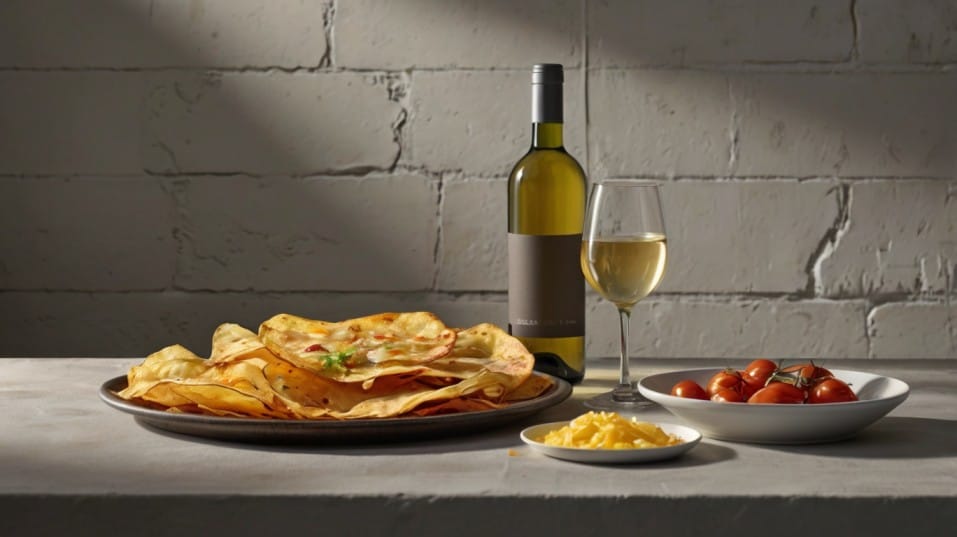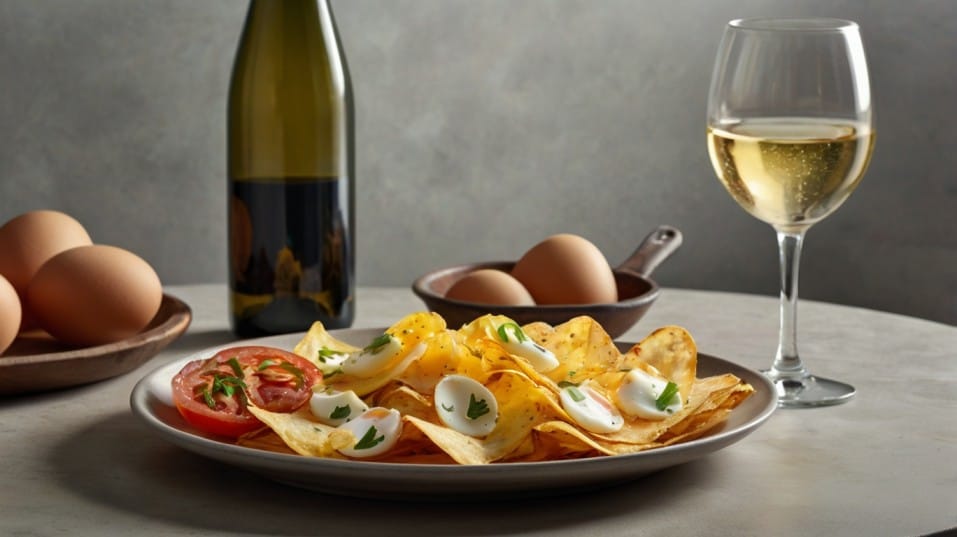Everyday Foods That Surprisingly Work with Wine
Everyday snacks can sharpen your wine skills. Learn how chips, pizza, and more help you taste smarter and pair with confidence.

What if your next wine lesson came from a slice of pizza or a bag of chips? You don’t need a sommelier’s toolkit to sharpen your palate.
In fact, pairing wine with familiar, everyday foods might be the fastest—and most surprising—way to understand structure, acidity, and balance.
Whether you’re curious, collecting, or just sipping with dinner, start simple. The best discoveries might be sitting in your pantry.
Chips, Fries, and Salted Snacks
Salt isn’t just a seasoning—it’s a sensory amplifier. In wine, it softens acidity, rounds out sharpness, and brings out hidden layers of fruit.
That’s why simple salted snacks are unexpectedly ideal companions for high-acid wines like dry Riesling, Albariño, or Champagne.
Potato chips with a crisp Chablis suddenly make sense: salt balances the acid, and fat from the oil draws out the wine’s subtle minerality.
French fries and a glass of Cava? It’s textural magic—crunch against bubbles, acid against starch. Even buttered popcorn finds harmony with a toasty Blanc de Blancs or an unoaked Chardonnay.
These pairings work because they’re clean and direct. There’s no sauce to confuse the palate, no spice to throw off balance.
Just a few base elements that allow you to feel what acidity and structure do in real time. Keep a few salty snacks on hand next time you're tasting—you’ll notice how even minor shifts in wine chemistry become obvious.

Pizza, Especially the Casual Kind
A slice of pizza is a study in contrast. Bright tomato acidity, fatty cheese, chewy crust, savory toppings—it’s a chaotic blend that demands a wine with both lift and grip. The solution? Medium-bodied reds with strong acid and soft tannins.
Barbera, Dolcetto, or Chianti Classico (with its Sangiovese backbone) stand up beautifully to pizza’s core ingredients without overwhelming them.
They echo the tomato’s acidity, buffer the fat in the cheese, and deepen the umami from cured meats or mushrooms.
What About White Wine?
For white wine drinkers, look for fuller-bodied whites with some phenolic texture—think Vermentino, Soave Classico, or even aged Pinot Gris.
If your pizza leans spicy or includes vegetables like arugula, artichoke, or olives, these whites can add the precision that many reds can’t.
The takeaway: don’t let the setting fool you. A greasy slice can teach you about tannin management, acidity matching, and how certain wines hold up under pressure.
Peanut Butter and Jam
Peanut butter and jam might seem like the last place to apply wine theory, but it offers one of the clearest examples of contrast and balance. Here, you’ve got salt, sugar, fat, and fruit—each one affecting how a wine behaves.
Try a chilled, off-dry white like Vouvray or Chenin Blanc with a PB&J, and you’ll see how the wine’s acidity cuts through the fat while its residual sugar mirrors the sweetness of the jam.
Beaujolais works too, thanks to its bright red fruit, low tannin, and juicy profile that fits right into the flavor profile without clashing.
What This Teaches You
What this teaches you: fat and sweetness aren’t obstacles—they’re opportunities.
If a wine seems too sharp or lean, pairing it with a food that adds roundness can create a more complete experience. That’s the heart of pairing: not just matching flavors, but completing them.
Eggs, in Almost Any Form
Eggs are often labeled “difficult” for wine, but that’s usually a result of choosing the wrong structure. Tannins and sulfurous compounds clash. Flabby whites get overwhelmed. The solution is simple: bubbles and acid.
Sparkling wines—especially Brut or Extra Brut styles—offer the precision needed to lift eggs without interference.
Whether you're having scrambled eggs, quiche, or a jammy-yolked soft boil, the fizz resets your palate after every bite and sharpens the perception of flavor.
Additions Change the Game
Add herbs, cheese, or greens to your eggs, and you can graduate to higher-acid still whites like Grüner Veltliner, dry Chenin Blanc, or even a lightly chilled red like Gamay.
The core idea is freshness with restraint: you want wines that clean the palate but don’t overpower the subtleties of the egg or its companions.
It’s a perfect study in tension and clarity. A simple egg dish paired well can teach you more about wine’s role in food than a steak ever could.
Mac and Cheese, or Creamy Pasta Dishes
Creamy dishes call for cut. That means acidity, texture, and in some cases, a hint of age. Mac and cheese might feel heavy and one-note, but paired with the right wine, it becomes a balanced, engaging experience.
Classic pairings like white Burgundy or Champagne work because they mirror the creaminess while bringing enough acid to lift the richness. Aged Crémant, oxidative whites from Jura, or even a structured white Rioja can do the same.
Dealing with Spice
With spicy versions—like mac and cheese with jalapeño or Cajun seasoning—you’ll want whites that offer cooling contrast: Albariño, Torrontés, or even an off-dry Riesling. These wines don’t fight the heat; they soften it and make room for flavor.
The key lesson here? Mouthfeel matters. Fat coats your palate. Wines with texture and acid reset it. The more you understand that cycle, the more naturally you’ll choose wines that enhance—not mute—your meals.
Tuna Salad, Chicken Salad, and Other "Lunchy" Foods
Don’t underestimate the learning potential of lunch. Tuna salad, chicken salad, deviled eggs—these often-overlooked staples are a playground for pairing. They bring mayo-based richness, protein, herbs, and sometimes crunch or fruit.
Dry rosé—especially Provençal styles—shines here, with enough acid to cut through mayo and enough fruit to meet the dish halfway.
Textured whites like Verdicchio, Fiano, or Sauvignon Blanc (particularly from the Loire or Alto Adige) keep things sharp without becoming overly grassy or citrusy.
How This Helps Your Palate
These pairings reveal how wine interacts with oil and protein. Too much acid and the wine turns sour. Too little and it feels dull. Find the balance, and you unlock the middle register of flavor—where nuance lives.
Final Thoughts
Wine education doesn’t start with rare vintages or tasting flights—it starts with noticing.
The foods you already eat can sharpen your sense of balance, build your vocabulary, and teach you how structure shapes experience. Acid, texture, fat, salt—these aren’t abstract concepts. They’re on your plate already.
So try it. Pick a wine you’re curious about. Open a bag of chips, fry an egg, or reheat a slice of pizza. Taste how the wine responds, what it highlights, what it hides. This is where confidence begins—not with perfection, but with attention.
Start today. Taste something familiar in a new way. And let the wine show you what it’s made of.




